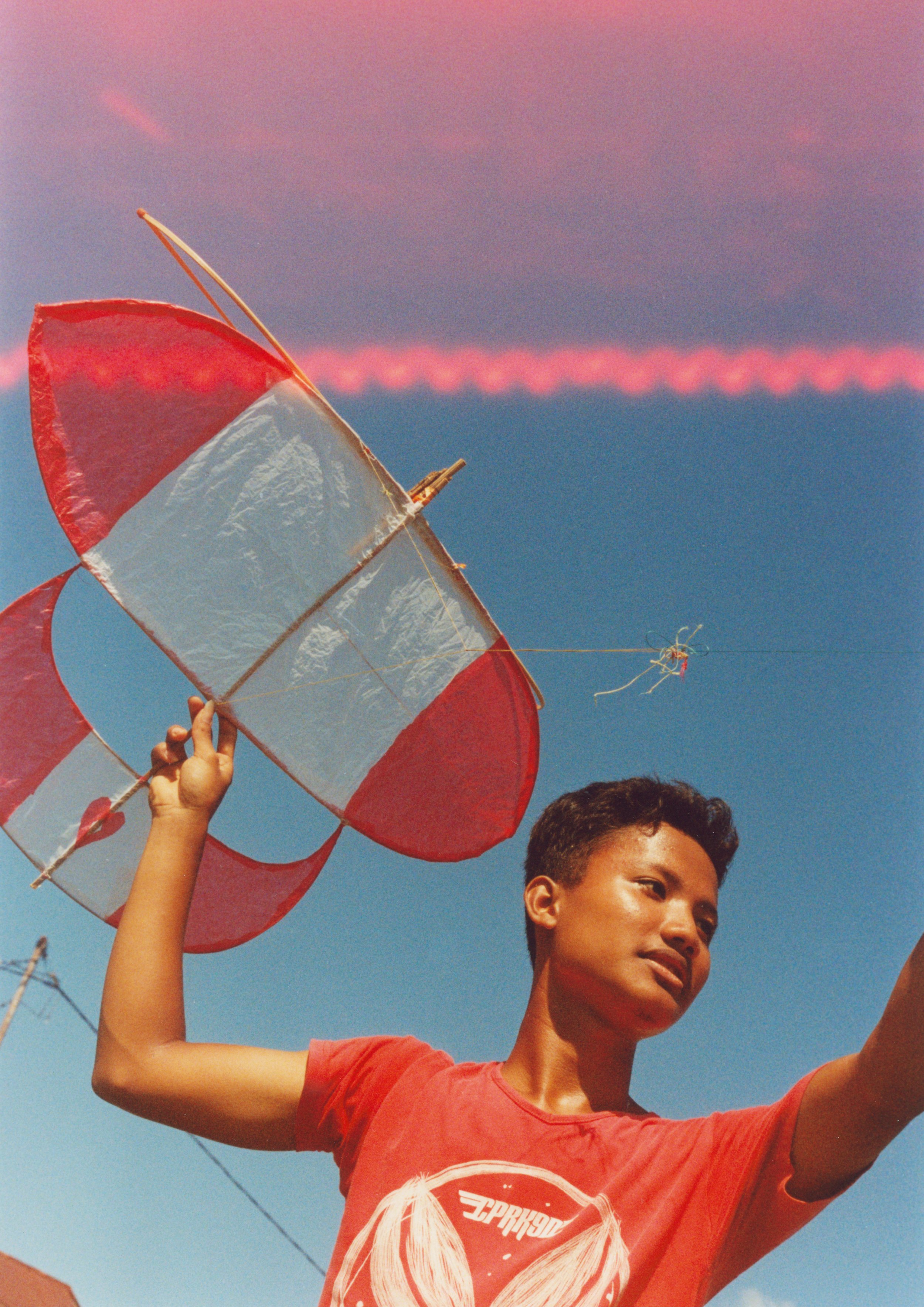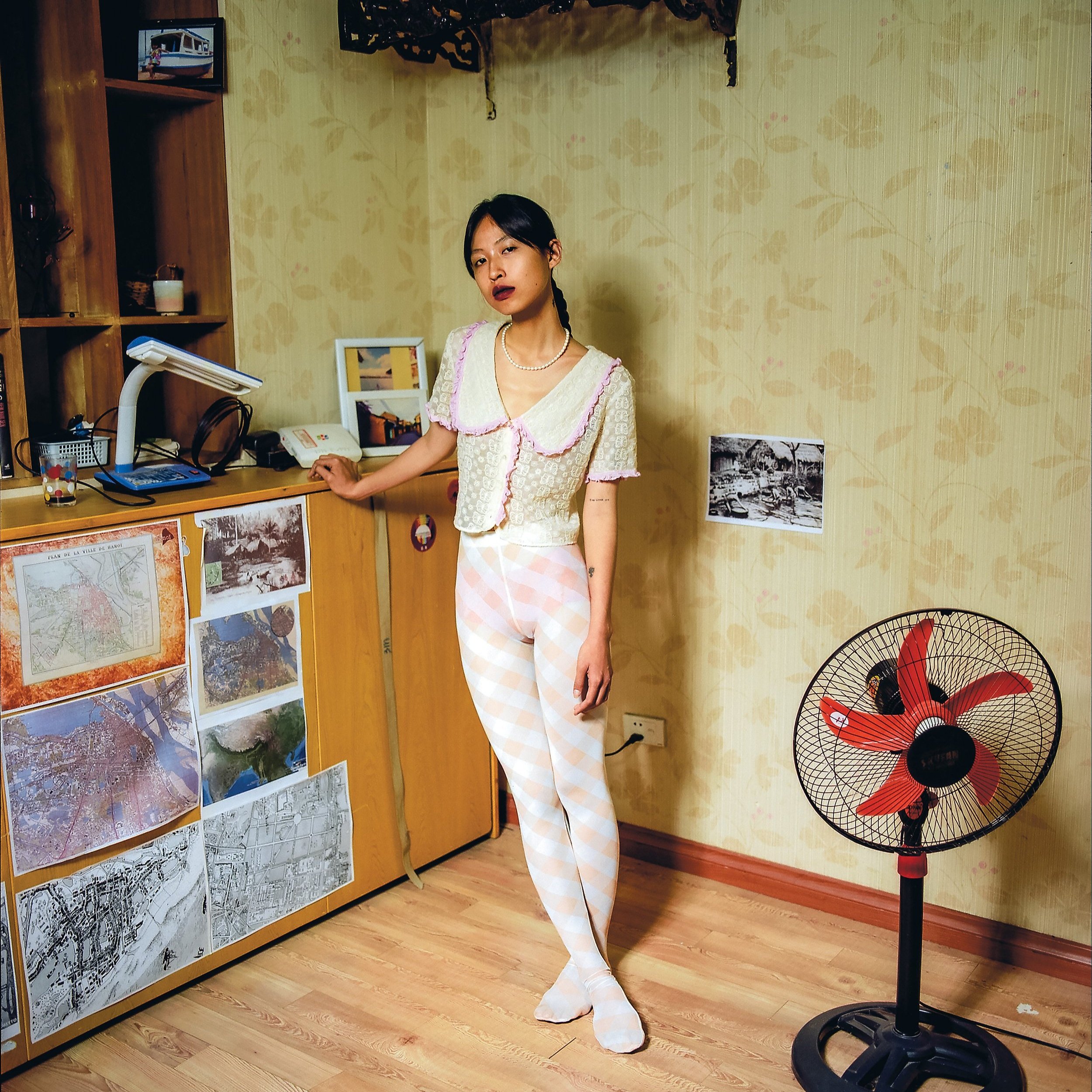Through the Lens: Farid Renais Ghimas
Portraits of home in Angan-Angan Harsa
By Sharrona Valezka
‘Through the Lens’ is a series that explores in detail images from fashion image-makers in Southeast Asia, shining a light on their creative and technical processes.
Farid Renais Ghimas is an Indonesian photographer whose visual imagery expresses his Indonesian identity in the form of documentaries and staged portraits. In 2018, he moved to the United Kingdom to pursue a BA in Fashion Photography at Leeds Arts University before continuing his studies at Central Saint Martins in 2022 for his MA in Fashion Communication: Fashion Image.
In this interview, Farid talks more about ‘Angan-Angan Harsa’, a photo series he created last year as a part of his final year project for his MA programme, and how it has played a significant role in discovering and developing his artistic identity as an emerging photographer in London.
‘Angan-Angan Harsa’, 2022. Image courtesy of Farid Renais Ghimas.
To start, we would like to know more about your image series, ‘Angan-Angan Harsa’. How would you describe the project and how did it initially come about?
‘Angan-Angan Harsa’ is an energetic exploration of joy set in the environmental settings of my birthplace in Bengkulu. It is a visual conversation about my identity as well as the lives of the people in my community. The title, which translates to ‘Dreams of Joy’ in Indonesian, encapsulates the essence of the project.
The series initially started as a final-year project for my MA in Fashion Communication: Fashion Image at Central Saint Martins. I told my tutor I was planning to return to Indonesia for the summer to make a project about my Indonesian upbringing. I have had the idea for quite some time, since I pursued my BA in Fashion Photography at Leeds Arts University. I travelled to Bengkulu in July last year and stayed for a month to create the photo series.
After years of living abroad, going back felt strange yet also familiar seeing that the surroundings had not changed much since my childhood. I was not sure where to start, but then I realised that what I was searching for was already present in my everyday scenes.
With this project, I was not attempting to construct or provoke specific thoughts. I was simply exploring and capturing images as a means to bridge my memories and experiences from my upbringing in Indonesia. While some people might relate to it, others might not fully grasp it. Nonetheless, each photograph stands as a fragment of my personal story and a method to maintain the bond I share with the place I call home.
‘Angan-Angan Harsa’, 2022. Image courtesy of Farid Renais Ghimas.
What informed your decision to go for a more documentary approach to the project? What would you like to communicate through the series?
To be honest, this is how I work best considering that I am a spontaneous person. If I go outside and set tasks for myself to take a few photos every day, I will end up with a greater number of pictures compared to organising photo shoots with a team of stylists, and hair and make-up artists. This could consume days or even weeks of my time.
Moreover, rather than creating images with an editorial sense, I find that capturing people in their natural living environments makes the pictures more relevant. A documentary approach allows the subjects to subtly hint at my experiences through them, without making it too literal.
Could you share more about the image-making process? What are some of the challenges you faced during the photo shoot, and how did you solve them?
The first two weeks were tough, mostly because my family did not want their photos taken. I told my MA programme tutor that I would be there for two weeks to get all of the pictures, but I ended up staying a month. Initially, I aimed to photograph only my family, but since that plan did not work out, I started going outside daily to approach people on the streets for pictures. Some were open to it, probably because I used a 35mm camera which felt less imposing. Completing a roll of the film meant it was a successful day.
After returning to London, I spent a lot of time in the darkroom, printing most of the images by hand. This part was actually more fun than taking the pictures. Then came the post production process: editing the photos, choosing which images fit together, designing the photobook layout, print testing, and more. While the process of taking the photos took a month to complete, the next three months were about making the whole project come to life.
‘Angan-Angan Harsa’, 2022. Images courtesy of Farid Renais Ghimas.
What worked smoothly when executing the images? Were there any parts that turned out differently from what you initially planned?
The last few weeks went quite smoothly, as everyone had already been used to me having a camera around. I could just meet them daily, and by then, everyone was already aware of my project and what I was doing. One thing that changed from my plan was deciding to photograph other people instead of just my family, which added more context about the region.
In an interview with It’s Nice That, you explained that building genuine relationships with the people you photographed developed an emotional connection that translated into the series. Could you elaborate more on this? How did it aid in delivering the narrative you intended to convey?
I believe that when making a community-based series like ‘Angan-Angan Harsa’, it is important to genuinely spend time with the people even when you are not taking pictures of them. There are these subtle aspects that tend to get overlooked, such as building relationships with the people, your experience photographing them, and how to use a camera with that person.
How you work with the people you photograph is as important as the technical skills, and I think the way you respect people in your images is also a skill. The way I approached the project was characterised by a multitude of questions: why did I decide to photograph this group of people? Is it because they are like me or that I wished to be like them?
I think if you can find yourself within the subject, you can mentally form some sort of interconnection with the image. Sometimes, it is also helpful to not visualise the final image in your head but to simply go out there and explore.
‘Angan-Angan Harsa’, 2022. Images courtesy of Farid Renais Ghimas.
How has your fashion photography work influenced your projects that are in the documentary style, and vice versa? Do you distinguish them as separate creative spaces, or actively seek to develop both areas simultaneously?
I do not see my fashion and documentary work as two separate things. Whether working on an editorial spread, a commercial fashion assignment, or a more self-motivated personal project, my main focus has been to make sure everyone is excited to have their photographs taken and to visualise them within the context that I envision.
Fashion, in any scenario, is such a powerful platform. While it is nice to work with designers when you are shooting an editorial, the absence of high-fashion clothes when shooting regular people does not make what they are wearing any less of a fashion statement. Fashion has a substantial role in our culture and we should not underestimate its potential impact.
“Fashion, in any scenario, is such a powerful platform. While it is nice to work with designers when you are shooting an editorial, the absence of high-fashion clothes when shooting regular people does not make what they are wearing any less of a fashion statement.”
‘Angan-Angan Harsa’, 2022. Images courtesy of Farid Renais Ghimas.
You have made the remark in Dazed Magazine that your practice often explores familiar settings and the notion of cultural identity as a result of struggling to relate to Western photography references. Could you share your journey of finding your artistic identity as an emerging Southeast Asian/Indonesian image-maker in London? And what are the opportunities that you look forward to?
It has been a long journey for me to finally figure out what I want to do with my work. I first came to the United Kingdom, when I was 18 years old, to study fashion photography. I did not fully understand what I was doing. I remember all of my classmates having extensive knowledge of various historical photographers, including what their work would be about and the issues they wanted to tackle. In contrast, at the time, my only motivation to join the course was because my sister is a fashion designer.
In my BA course, there was a lot of emphasis on the technical side of photography. I learned about studio lighting, types of cameras, different mediums, and more. Although it has helped me to become better at taking pictures, I feel like I did not have a critical outlook within my work yet. My tutors would also show us the work of many photographers in class for research purposes. And of course, when you are just starting out, you would want your work to be similar to the photographers you idolise. So there was a certain period where I referenced all these photographers in my work. I started having their work in my mood boards, doing model test shoots, and following these flawless approaches to taking pictures. But as time went by, I realised that I was trying to be something I was not.
During my final year in 2020, I had to return to Indonesia and because of the pandemic restrictions, I stayed there for more than half a year to finish my final-year project. At the time, I felt bored at home and missed taking pictures, but I could not plan anything because of the lockdown restrictions. As a result, I took trips to my grandmother’s village in Comal, Central Java, and took pictures of my family members there. That was how I started to discover this passion to make my work about my own Indonesian identity. Then, I started to incorporate these elements into my more fashion-related projects, but the results were not what I initially envisioned. There was too much styling, the model casting was not right, and most of the time, it ended up being pictures of pretty models in pretty clothes.
‘Angan-Angan Harsa’, 2022. Images courtesy of Farid Renais Ghimas.
After I felt I had figured out what I wanted to do with my work going forward, I applied to Central Saint Martins for their MA Fashion Communication: Fashion Image programme. Studying at Central Saint Martins has helped me a lot in terms of shaping my creative identity. My programme tutor, Adam Murray, was one of the main reasons I had a breakthrough with my project. I remember coming onto the course thinking that I already had a decent amount of knowledge about fashion photography, but after I attended his class for one or two weeks, I felt like I knew nothing at all. I admire the way his mind thinks about fashion imagery and how he expresses what he believes in. This has helped encourage me to push the boundaries within myself and my work.
On my initial idea of the project, he told me that I had a great foundation to build upon based on my interests, and looking at personal backgrounds would be a good place to start. Although it still looked like a general project about a big topic, his advice was to focus on smaller aspects, which would enable me to convey a more significant narrative. Everything he said turned out to be true. I used to believe that depicting Indonesia in images required dressing Indonesian models in traditional clothing, but I realised that this approach feels forced and artificial.
Of course, as a minority here in the United Kingdom, we tend to feel the need to represent our culture in the most authentic way possible. But then why would I be given the burden to represent a whole group of people who have lived completely different lives than I have? What I can talk about through my work is my own experience because I have control over that. Instead of trying to speak for the whole nation, I have decided to shift my focus to my own experience growing up in Indonesia and building the narrative around the people and places that have shaped me. That was the starting point of ‘Angan-Angan Harsa’.
“What I can talk about through my work is my own experience because I have control over that. Instead of trying to speak for the whole nation, I have decided to shift my focus to my own experience growing up in Indonesia and building the narrative around the people and places that have shaped me.”
‘Angan-Angan Harsa’, 2022. Images courtesy of Farid Renais Ghimas.
Finally, what plans do you have in store for your practice moving forward? Do you have any projects that you are working on?
Currently, I want to keep working on ‘Angan-Angan Harsa’ and its resulting photo publication, since I only made a prototype for my final year project submission. I think there are still a lot of opportunities to refine and develop it in the future. I will also have to decide to self-publish or work with a publisher. For now, we will have to see.
See more of Farid’s work here or on Instagram at @faridrenais.
























